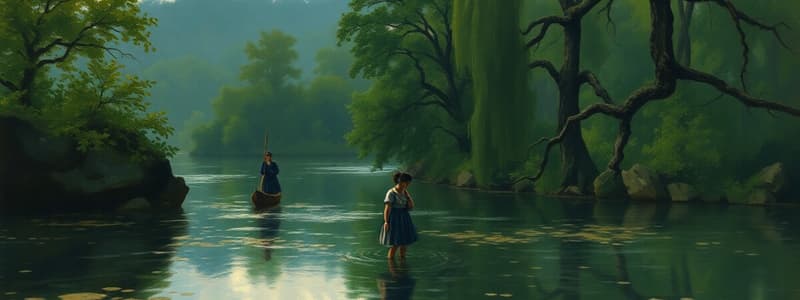Podcast
Questions and Answers
What is the primary characteristic of a scene in visual storytelling?
What is the primary characteristic of a scene in visual storytelling?
- It primarily consists of dialogue.
- It includes only one character's point of view.
- It must always be at least one minute long.
- It is defined by a single continuous action or setting. (correct)
Which of the following elements is NOT typically considered a part of a scene?
Which of the following elements is NOT typically considered a part of a scene?
- Action
- Character soundtrack (correct)
- Setting
- Dialogue
What does the progression of events in a scene typically lead to?
What does the progression of events in a scene typically lead to?
- A plot twist only.
- A climax followed by an outcome or resolution. (correct)
- A lengthy exposition.
- An immediate transition to the next scene.
Which type of scene focuses on the core events of the plot?
Which type of scene focuses on the core events of the plot?
How is dramatic tension typically created within a scene?
How is dramatic tension typically created within a scene?
What differentiates a scene from a shot in visual storytelling?
What differentiates a scene from a shot in visual storytelling?
Which scene structure element typically initiates the viewer's understanding of the setting?
Which scene structure element typically initiates the viewer's understanding of the setting?
What role does sound play in a scene?
What role does sound play in a scene?
Flashcards
Scene
Scene
A fundamental unit in storytelling, typically a single continuous action or setting in a film or TV show.
Scene Elements
Scene Elements
The components of a scene, including setting, action, characters, dialogue, visuals, and sound, all working together to build mood and plot progression.
Scene Structure
Scene Structure
The typical organization of a scene, often starting with an establishing shot, progressing towards a climax and resolution.
Scene Construction
Scene Construction
Signup and view all the flashcards
Scene vs. Shot
Scene vs. Shot
Signup and view all the flashcards
Exposition Scene
Exposition Scene
Signup and view all the flashcards
Action Scene
Action Scene
Signup and view all the flashcards
Internal Scene
Internal Scene
Signup and view all the flashcards
Study Notes
Definition and Scope
- Scene is a fundamental unit of storytelling in film, television, and other visual media.
- It's typically defined as a single continuous action or setting.
- Scenes are characterized by location, time, and the actions and interactions of the characters.
- Scenes build upon each other, progressing the plot and revealing character development.
- Scenes can be as short as a few seconds or as long as several minutes depending on the narrative.
Elements of a Scene
- Setting: The location, time of day, and atmosphere affecting the scene.
- Action: The physical and emotional activity that takes place, driving the scene forward.
- Characters: Their motivations, interactions, and developments within the scene.
- Dialogue: The words the characters speak.
- Visuals: Camera angles, shots, lighting, editing, visual effects, and composition.
- Sound: Music, sound effects, and ambient noise. These contribute to mood and atmosphere, and may include dialogue and sound effects (e.g. footsteps).
Scene Structure
- Scenes usually follow a logical structure, progressing in a way that helps the audience understand and feel involved.
- Scenes often begin with an establishing shot, visually defining both the key location and conditions.
- They usually contain some kind of inciting incident, problem, or action that propels the scene forward.
- The progression of events leads to a climax, followed by an outcome or resolution.
Scene Construction
- Often scenes contain dramatic tension, usually built during its progression.
- They use specific techniques to develop the characters, convey narrative information, or evoke emotion in the audience.
- A well-constructed scene is clear, compelling, and efficiently helps advance or clarify the plot.
Scene vs. Shot
- A shot is a single uninterrupted run of the camera.
- A scene typically contains multiple shots, often a series that are edited together.
- Editing of shots within a scene is crucial in creating the desired pace, tone and effect.
Types of Scenes
- Exposition: Establishes background information.
- Action: Focuses on the core events of the plot.
- Dialogue-driven: Emphasizes character interaction and relationships through conversations.
- Internal: Delves into a character's thoughts and feelings, sometimes without a strong external plot element.
- Flashback: Uses a moment in time to explain a current event or plot.
- Dream/Vision: Offers a look inside a character's mind or subconscious.
Purpose of Scenes
- Primarily, scenes move the plot forward.
- They develop characters.
- They provide emotional impact on the viewer.
Studying That Suits You
Use AI to generate personalized quizzes and flashcards to suit your learning preferences.




